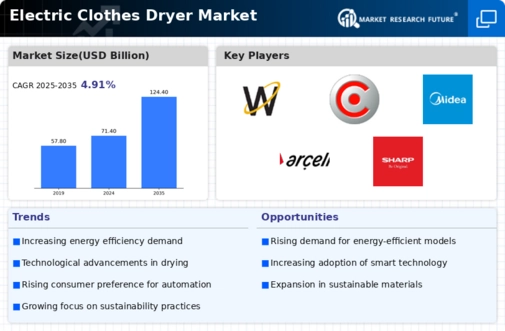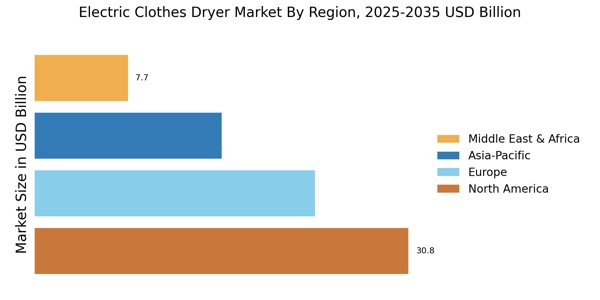The Electric Clothes Dryer Market is currently characterized by a dynamic competitive landscape, driven by innovation, sustainability, and technological advancements. Major players such as Whirlpool (US), LG Electronics (KR), and Bosch (DE) are actively shaping the market through strategic initiatives that emphasize energy efficiency and smart technology integration. Whirlpool (US) has positioned itself as a leader in the market by focusing on user-friendly designs and connectivity features, while LG Electronics (KR) leverages its expertise in smart home technology to enhance consumer engagement. Bosch (DE), on the other hand, emphasizes sustainability in its product offerings, appealing to environmentally conscious consumers. Collectively, these strategies contribute to a competitive environment that prioritizes technological innovation and consumer-centric solutions.
Key business tactics within the Electric Clothes Dryer Market include localizing manufacturing and optimizing supply chains to enhance operational efficiency. The market appears moderately fragmented, with several key players holding substantial market shares. This fragmentation allows for a diverse range of products and innovations, fostering competition among established brands and new entrants alike. The collective influence of these key players is significant, as they continuously adapt to changing consumer preferences and regulatory requirements, particularly in terms of energy efficiency and sustainability.
In August 2025, Whirlpool (US) announced the launch of its new line of energy-efficient dryers, which utilize advanced heat pump technology. This strategic move not only aligns with the growing consumer demand for sustainable appliances but also positions Whirlpool to capitalize on regulatory trends favoring energy-efficient products. The introduction of these dryers is expected to enhance Whirlpool's market share and reinforce its commitment to sustainability.
In September 2025, LG Electronics (KR) unveiled its latest AI-powered dryer, which features a smart diagnosis system that allows users to troubleshoot issues via a mobile app. This innovation reflects LG's ongoing investment in smart home technology, aiming to provide consumers with enhanced convenience and control over their laundry processes. By integrating AI capabilities, LG is likely to strengthen its competitive edge in the market, appealing to tech-savvy consumers seeking advanced features.
In July 2025, Bosch (DE) expanded its product line to include a new series of compact dryers designed for urban living spaces. This strategic expansion caters to the increasing demand for space-saving appliances in densely populated areas. By addressing the specific needs of urban consumers, Bosch is positioning itself as a versatile player in the market, potentially increasing its customer base and market penetration.
As of October 2025, current competitive trends in the Electric Clothes Dryer Market are heavily influenced by digitalization, sustainability, and the integration of artificial intelligence. Strategic alliances among key players are becoming increasingly common, as companies seek to enhance their technological capabilities and market reach. The competitive differentiation is likely to evolve from traditional price-based competition to a focus on innovation, technology integration, and supply chain reliability, reflecting the changing landscape of consumer expectations and regulatory pressures.


















Leave a Comment